The failure of Taojiji may be related to the cold winter of capital, but the problems of the enterprises themselves are even greater.
Editor’s note: This article is from WeChat public account “ 投 中 网 ” (ID: China-Venture), author Lin Ju, editor Chen Ziyang.
Taojiji’s bankruptcy and liquidation, financing caused by the cold winter capital is difficult to become one of the reasons. But in fact, the money of the head agency is still sufficient, but they are more cautious in their shots and have higher requirements for the project.
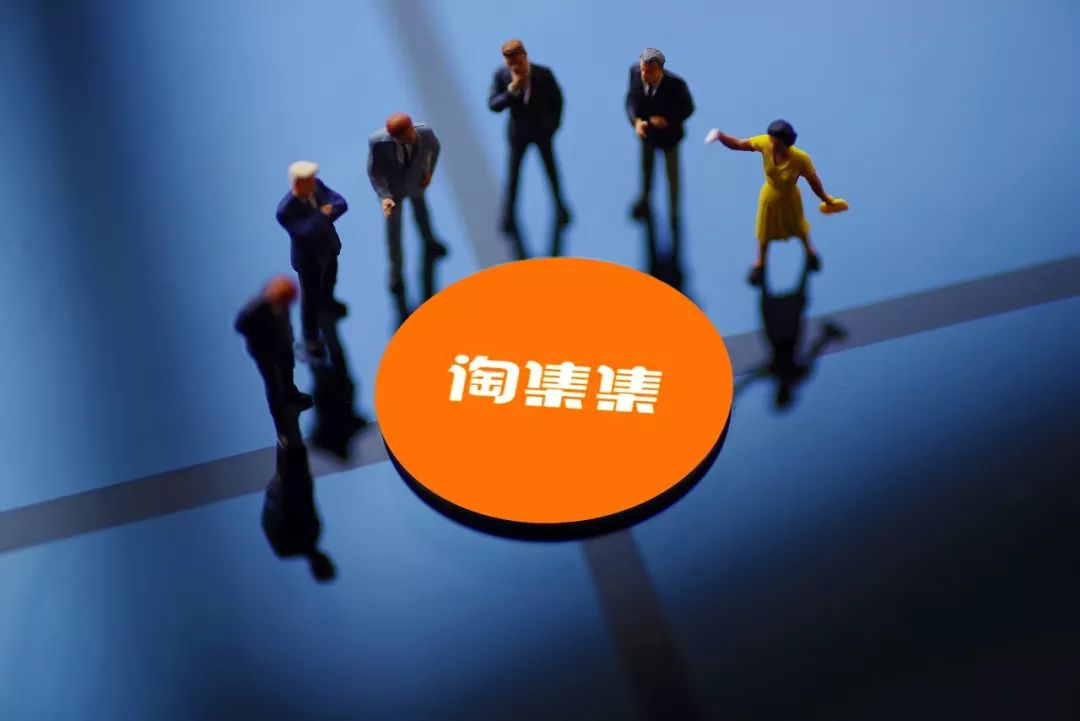
The overall size of investment and financing has indeed decreased this year, but if averaged, the single investment has not decreased.
2019 is coming to an end, but the bad news in the investment and financial circle seems to continue.
Similar to the Taojiji of Pinduoduo mode, due to financing failure, announced the reorganization failure and entered the bankruptcy liquidation stage. On the same day, fresh food e-commerce company Ji Hexian was exposed to financing failure and will undergo large-scale layoffs.
Bad news one after another. For example, in the field of car manufacturing, the $ 500 million round of Byton C financing has not been completed for a year. Xiaopeng Automobile received US $ 400 million in financing, but US $ 200 million less than its original target.
Is the cold winter of the capital even colder?
Zhu Zheng, an analyst at a well-known investment bank, told China Investment Network that the financing environment this year does look very poor. Due to the impact of the overall economy this year and the fact that most of the investment institutions’ previous projects have not exited, many institutions have shot. cautious. But in fact, the money of the head agency is still sufficient, but they are more cautious in their shots and have higher requirements for the project.
Data obtained by China Investment Network also illustrates this phenomenon. According to CVSource’s investment data, the overall scale of investment and financing did decrease this year, but if averaged, single investment did not decrease. Specifically, in 2019, the average amount of each financing reached 127 million yuan, the second highest since 2014-lower than the 145 million yuan in 2018.
“There are indeed changes in the general environment, but there may be more problems for the enterprises themselves.” Li Yikai, a partner of a Shanghai-based asset management company, told CIC. This is also the point of view of most investors contacted by CIC.
The financing environment is poor, or is there a problem with the model?
In the model for Taojiji, Li Yikai pointed out that he mismanaged the cash flow cycle.
Taojiji seeks Series B financing in June this yearA while ago, nearly a year has passed since the last round of financing. In October 2018, Taojiji received US $ 42 million in Series A financing from Tiger Global Fund, Russia’s DST, and Dianfeng Investment.
Li Yikai believes that after the start-up company has received the first money, it will re-evaluate whether it can continue to receive money after 3-5 months. “Under normal circumstances, a fund may be maintained for 12-18 months, which means that in the 8th or 9th month, you must ensure that you have a new round of funding.” He said, especially Taojiji belongs to e-commerce The industry needs to burn more money in this fiercely competitive field, “perhaps overly optimistic about its financing ability.”
TouChina has previously reported that Taojiji is one of the most concerned projects in 2018. In July 2018, Pinduoduo, which was established for only 3 years, was listed. As a result, social e-commerce, which is similar to Pinduoduo, is doing a buy-in model in a sinking market, and has attracted attention from the capital market. Taojiji is one of the star projects, and many investors scramble to enter the bureau. Less than a year, Taojiji fell to the “Altar of God”.
More than one investor told CIC that blindly subsidizing, but unable to gain user stickiness, such a “burning money” method is meaningless. In the past few months, the fund gap of Taojiji has been close to 2 billion yuan, mainly spent on price wars and user subsidies, and at the same time, the repayments to merchants have been used-only after entering the merchants to collect debts.
Similarly, the same is true of fresh food e-commerce and fresh food. The company, which was established in October 2018, also took IDG and Jingwei China’s Pre-A and A rounds of financing in the first half of this year. Fresh food e-commerce has high customer acquisition costs, high losses, and very high supply chain requirements. There is no end to the funds that need to be invested. There have been rumors in the market that in order to obtain financing, Ji Jixian visited more than 100 investors within three months.
More importantly, whether it’s a fight or fresh. “Giants” already exist. Pinduoduo, Alibaba’s great deal, and JD.com also did Jingxi in WeChat. Fresh products are fresh from Hema, fresh elephant elephants, Jingdong fresh, and Suning fresh. How many opportunities do new players have?
Zhu Zheng said that Pinduoduo also started from a new player. It can only be said that the current environment is different from three or four years ago. Li Yikai also told China Investment Network that when there is a lot of money, investment institutions will invest a few to see who runs out.
“(Actually) the sinking market is still an under-satisfied market. It depends on who can really achieve good goods and services in the hearts of these consumers.” Li Haoming, general manager of private equity funds, told China Investment Network. He believes that the failure of enterprises should not be attributed to the disadvantage of financing.
Is the investment environment really bad?
At a time when financing difficulties are everywhere, Time Media ’s “Time Data》 According to statistics, 327 companies have closed down in the first 11 months of 2019, which is three times the same period last year. In the next less than a month, this number may continue to increase due to lack of funds (458 closed in 2018).
The tide of failure of startups is inevitably reminiscent of the capital winter, but the market environment may not be so negative.
CVSource investment data shows that the scale of investment and financing has indeed decreased this year, but the average single investment has not decreased. Specifically, in 2019, the average amount of each financing reached 127 million yuan, the second highest since 2014-lower than the 145 million yuan in 2018.
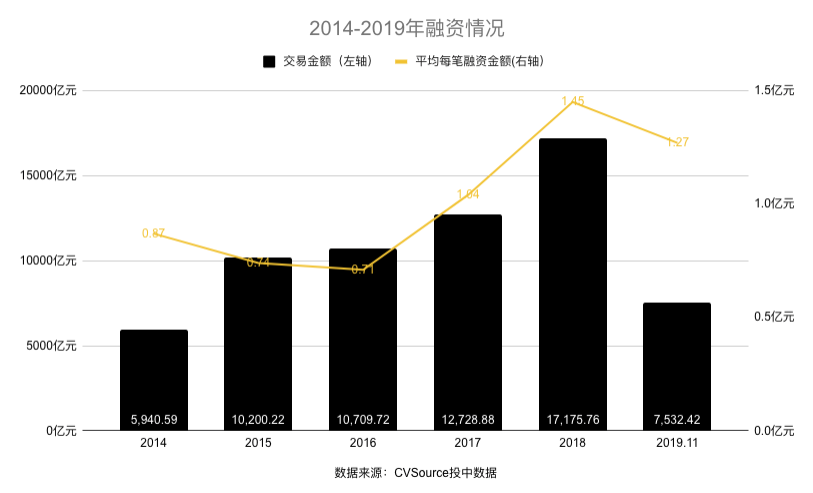
In the field of e-commerce, the average amount of financing for this year is 557 million yuan, the highest since 2014.

In fact, the fundraising environment for the fund has deteriorated, and it has begun in 2017. The cold winter of capital has also been in public view ever since. But good projects are still favored by capital. Judging from the results, Pinduoduo took 5 rounds of financing during 2016-2018, exceeding $ 1.7 billion.
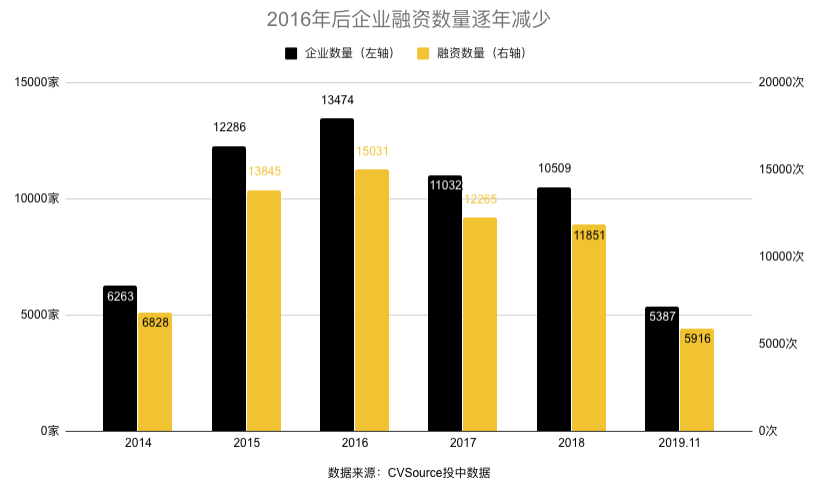
Although the number of funds this year is small, the size of the first 11 months is almost the same as last year. The CVSource investment data shows thatA total of 480 RMB funds and USD funds raised 120.662 billion US dollars in one month, which was almost the same as the 124.449 billion US dollars raised by 862 funds in 2018. On average, each fund raised an average of $ 251 million, higher than the average of the past five years.
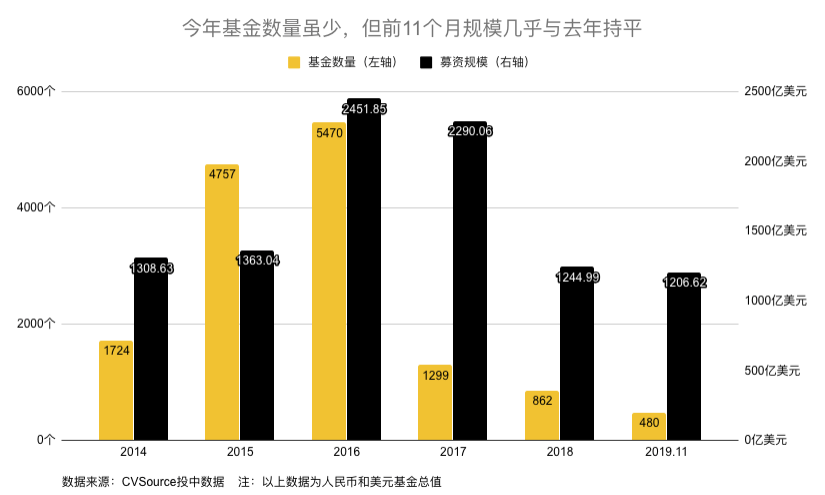
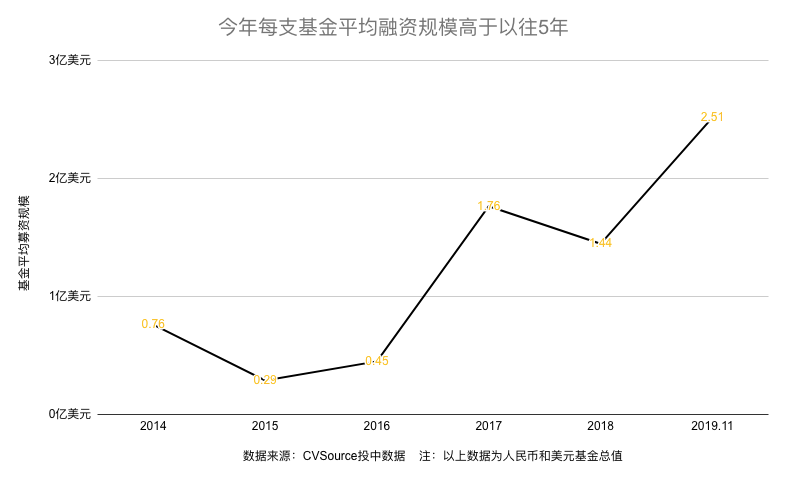
” Some agencies in the head still have food, but they have It is necessary to consider whether there will be follow-up after the investment, so it will be more cautious, which will cause the overall financing funds to be tight. “Luo Huan, executive director of Liangxinglu (Beijing) Asset Management, told CIC.
So what kind of project did the cautious investor give the money to?
Li Haoming, who is concerned about the science and technology board, told CIC that this year’s financing will focus more on the areas surrounding the listing standard of the science and technology board registration system and whether it can truly achieve supply-side reforms, such as black technology and new consumption .
Zhu Zhengzhu said that this year, the overall trend is more towards TO B projects, big data, cloud services, industrial Internet, etc.
CVSource investment data shows that in the fields of finance, internet, healthcare, real estate, and manufacturing, the largest number of investment and financing transactions and transaction amounts in the past year have been concentrated in manufacturing. In the past year, the number of manufacturing transactions was 2,377, and the transaction value reached 910.933 billion yuan, a year-on-year increase of 4.11%.
Indeed, when Internet traffic peaks, many consumer market projects have basically come out. Moreover, as mobile Internet dividends drift away, TO B has become the key to the continued growth of enterprises. Beginning last year, large companies such as Tencent announced their transformation to TO B, and Meituan actively provided diversified services to merchants.
According to the QuestMobile report, in the second quarter of 2019, China Mobile’s Internet users experienced a net decrease of 2 million.For the first time, negative growth has occurred. At the same time, the growth rate of the average usage time of mobile Internet users continued to slow down, from 22.6% in the fourth quarter of 2018 to 11.8% in the first quarter of 2019, and then to 6% in the second quarter.
Li Yikai, who is concerned about the secondary market, also told China Investment Network that although the TO B project has a long growth cycle, it takes at least one year for companies to transition in the secondary market before data comes out. It is difficult to have projects again.
(At the request of the interviewer, Li Yikai, Zhu Zheng, and Li Haoming are pseudonyms)
At a time when financing difficulties are everywhere, Time Media ’s “Time Data》 According to statistics, 327 companies have closed down in the first 11 months of 2019, which is three times the same period last year. In the next less than a month, this number may continue to increase due to lack of funds (458 closed in 2018).
The tide of failure of startups is inevitably reminiscent of the capital winter, but the market environment may not be so negative.
CVSource investment data shows that the scale of investment and financing has indeed decreased this year, but the average single investment has not decreased. Specifically, in 2019, the average amount of each financing reached 127 million yuan, the second highest since 2014-lower than the 145 million yuan in 2018.

In the field of e-commerce, the average amount of financing for this year is 557 million yuan, the highest since 2014.
In fact, the fundraising environment for the fund has deteriorated, and it has begun in 2017. The cold winter of capital has also been in public view ever since. But good projects are still favored by capital. Judging from the results, Pinduoduo took 5 rounds of financing during 2016-2018, exceeding $ 1.7 billion.

Although the number of funds this year is small, the size of the first 11 months is almost the same as last year. The CVSource investment data shows thatA total of 480 RMB funds and USD funds raised 120.662 billion US dollars in one month, which was almost the same as the 124.449 billion US dollars raised by 862 funds in 2018. On average, each fund raised an average of $ 251 million, higher than the average of the past five years.


” Some agencies in the head still have food, but they have It is necessary to consider whether there will be follow-up after the investment, so it will be more cautious, which will cause the overall financing funds to be tight. “Luo Huan, executive director of Liangxinglu (Beijing) Asset Management, told CIC.
So what kind of project did the cautious investor give the money to?
Li Haoming, who is concerned about the science and technology board, told CIC that this year’s financing will focus more on the areas surrounding the listing standard of the science and technology board registration system and whether it can truly achieve supply-side reforms, such as black technology and new consumption .
Zhu Zhengzhu said that this year, the overall trend is more towards TO B projects, big data, cloud services, industrial Internet, etc.
CVSource investment data shows that in the fields of finance, internet, healthcare, real estate, and manufacturing, the largest number of investment and financing transactions and transaction amounts in the past year have been concentrated in manufacturing. In the past year, the number of manufacturing transactions was 2,377, and the transaction value reached 910.933 billion yuan, a year-on-year increase of 4.11%.
Indeed, when Internet traffic peaks, many consumer market projects have basically come out. Moreover, as mobile Internet dividends drift away, TO B has become the key to the continued growth of enterprises. Beginning last year, large companies such as Tencent announced their transformation to TO B, and Meituan actively provided diversified services to merchants.
According to the QuestMobile report, in the second quarter of 2019, China Mobile’s Internet users experienced a net decrease of 2 million.For the first time, negative growth has occurred. At the same time, the growth rate of the average usage time of mobile Internet users continued to slow down, from 22.6% in the fourth quarter of 2018 to 11.8% in the first quarter of 2019, and then to 6% in the second quarter.
Li Yikai, who is concerned about the secondary market, also told China Investment Network that although the TO B project has a long growth cycle, it takes at least one year for companies to transition in the secondary market before data comes out. It is difficult to have projects again.
(At the request of the interviewer, Li Yikai, Zhu Zheng, and Li Haoming are pseudonyms)